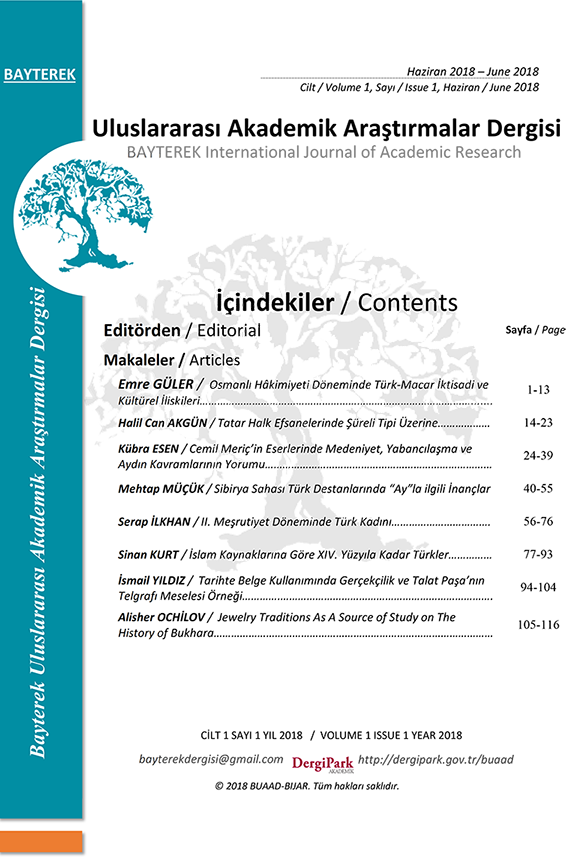
Bayterek Uluslararası Akademik Araştırmalar Dergisi
Yazarlar: Emine YILDIZ ARIGANOĞLU
Konular:Eğitim, Bilimsel Disiplinler
DOI:10.48174/buaad.933405
Anahtar Kelimeler:Class leadership,Teacher leadership,Teacher; Leadership.
Özet: The teacher, who is a class leader, can be defined as a person who fulfills his teaching responsibilities in the classroom, has good communication with administrators, colleagues, students and parents in the school environment, uses his time effectively and efficiently, is open to innovations and changes, works towards self-improvement, and exhibits a democratic attitude towards his students. The main framework of this study is to determine how well teachers are aware of the leadership characteristics they have. In this context, the problem sentence of the research is "How are teachers' awareness of classroom leadership? determined as. The aim of this study is to examine the class leadership awareness of teachers working at different levels in Adana. The research was carried out using an explanatory sequential design in mixed model. The mixed method was chosen in order to obtain a more valid research by integrating the results obtained from both quantitative and qualitative data. Although this study is mainly a descriptive study in the scanning model in the quantitative dimension, it was supported by using the qualitative phenomenological model. The study population of this research consists of teachers working in primary schools, secondary schools and high schools in the central districts of Adana (Çukurova, Seyhan, Sarıçam, Yüreğir). The sample of the study was determined using the simple random sampling method, and in the first semester of the 2019-2020 academic year, 406 teachers (88 class teachers, 292 branch teachers) were working in a total of 24 public schools, 10 of which were primary schools, 12 secondary schools and two high schools, in Adana's central districts. First, quantitative data were collected with the Teacher Class Leadership Scale. This form consists of three factors: interaction, out-of-school processes, and classroom processes. There are a total of 23 items in the form. Then, through the Teacher Class Leadership Interview Form created by the researcher, interviews were made with the teachers selected among the teachers who participated in the research in quantitative scale. During the preparation of the interview form, the literature was scanned, a draft form was prepared and presented to expert opinion. It was arranged in line with expert opinion and took its final form in the form of a semi-structured form consisting of four questions. Interviews were conducted with 11 teachers who volunteered to have audio recordings from the teachers. Five teachers who did not want to be recorded were given a written interview form with open-ended questions. Teachers were asked to state their opinions on the questions by writing them in the spaces under each question. Extra questions were asked for the missing parts in the written form. The quantitative data of the study were applied in a single session by organizing the Personal Information Form and the Teacher Class Leadership Scale together in a single form to teachers in different branches who work in different schools in December 2019. Descriptive statistics, t-test and one-way analysis of variance were used in the analysis of quantitative data. Descriptive analysis was used in analyzing qualitative data. As a result of the research, it was determined that teachers' awareness of classroom leadership was high. While teachers' awareness of classroom leadership did not differ according to gender; It has been determined that it differs according to seniority, branch, level of work and socioeconomic level of the school. In the qualitative dimension of the study, it was observed that teachers perceived their classroom leadership negatively in their own schools, but they perceived their own classroom leadership positively. In addition, they stated that they tried to improve the class leadership of the participants by following the developments with vocational training and observation. In order to increase their awareness and skills in classroom leadership, they most frequently responded to communication with students, personal development and being a model. Based on the results of this research, trainings and seminars can be organized to raise awareness of teachers about classroom leadership. Studies can be conducted to increase teachers' awareness of classroom leadership. While they see their own classroom leadership positively, the reasons for teachers in their schools to see their classroom leadership negatively can be investigated. Similar studies can be done with larger samples in different cities, at different levels, with different variables.
Dergi editörleri editör girişini kullanarak sisteme giriş yapabilirler. Editör girişi için tıklayınız.